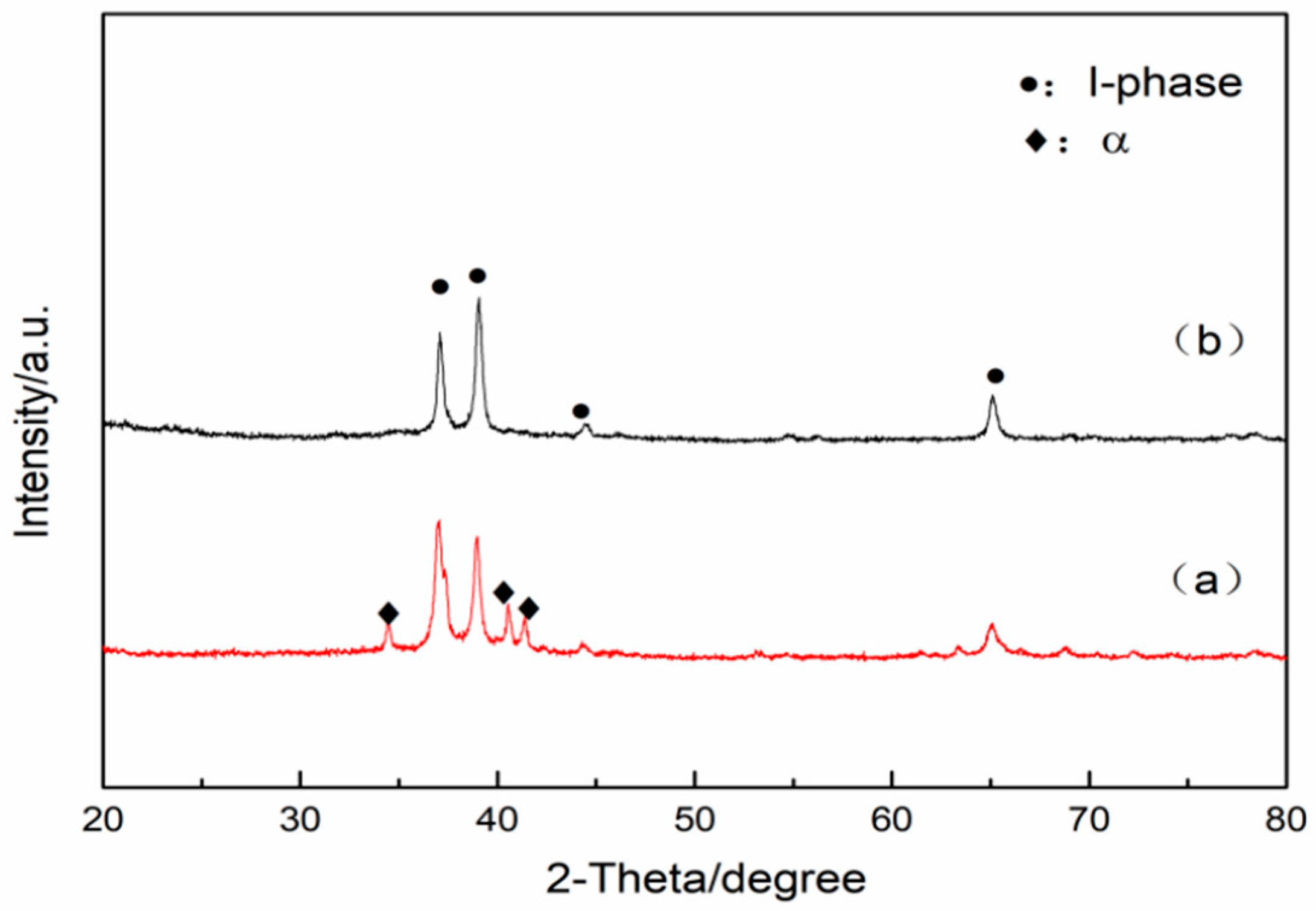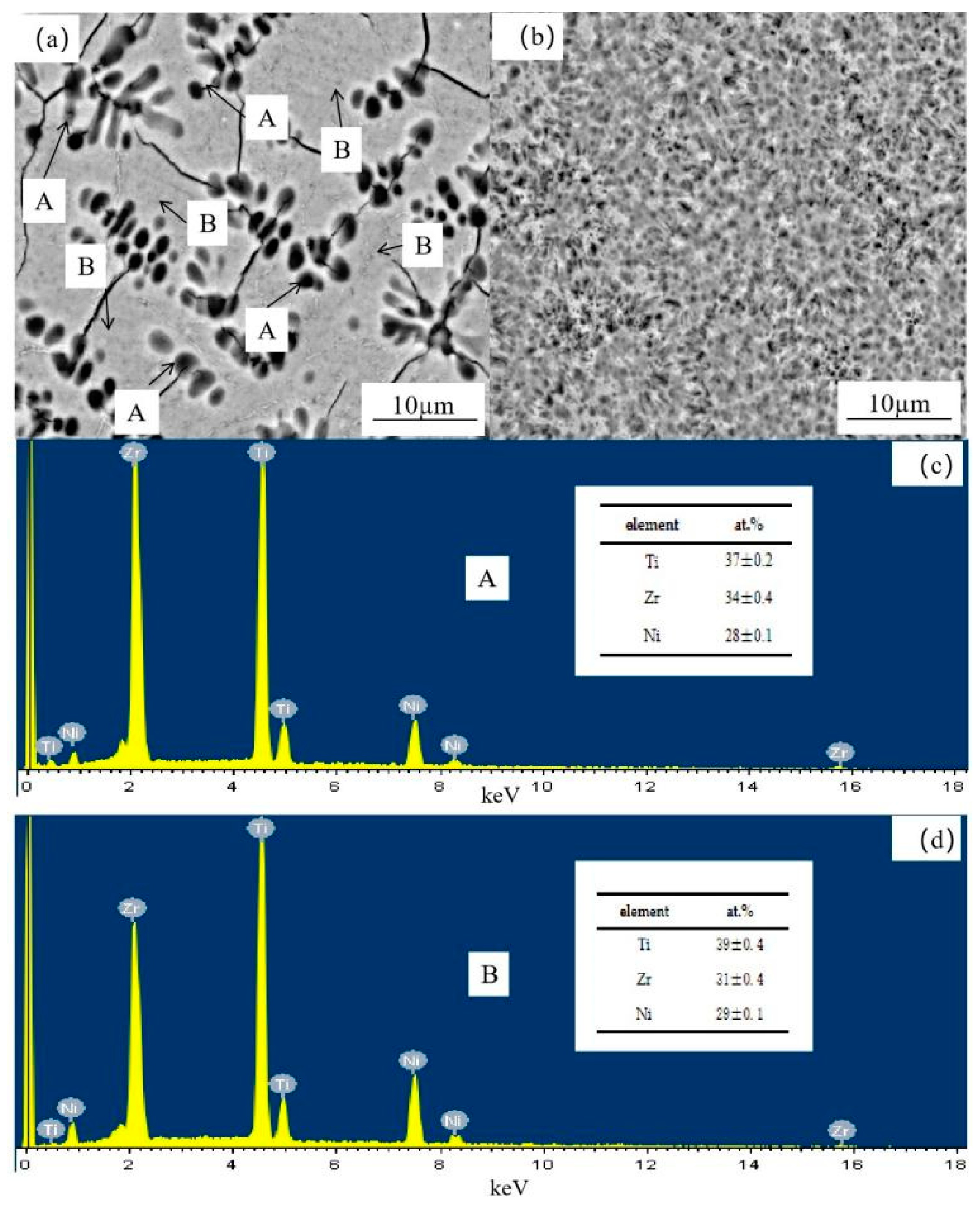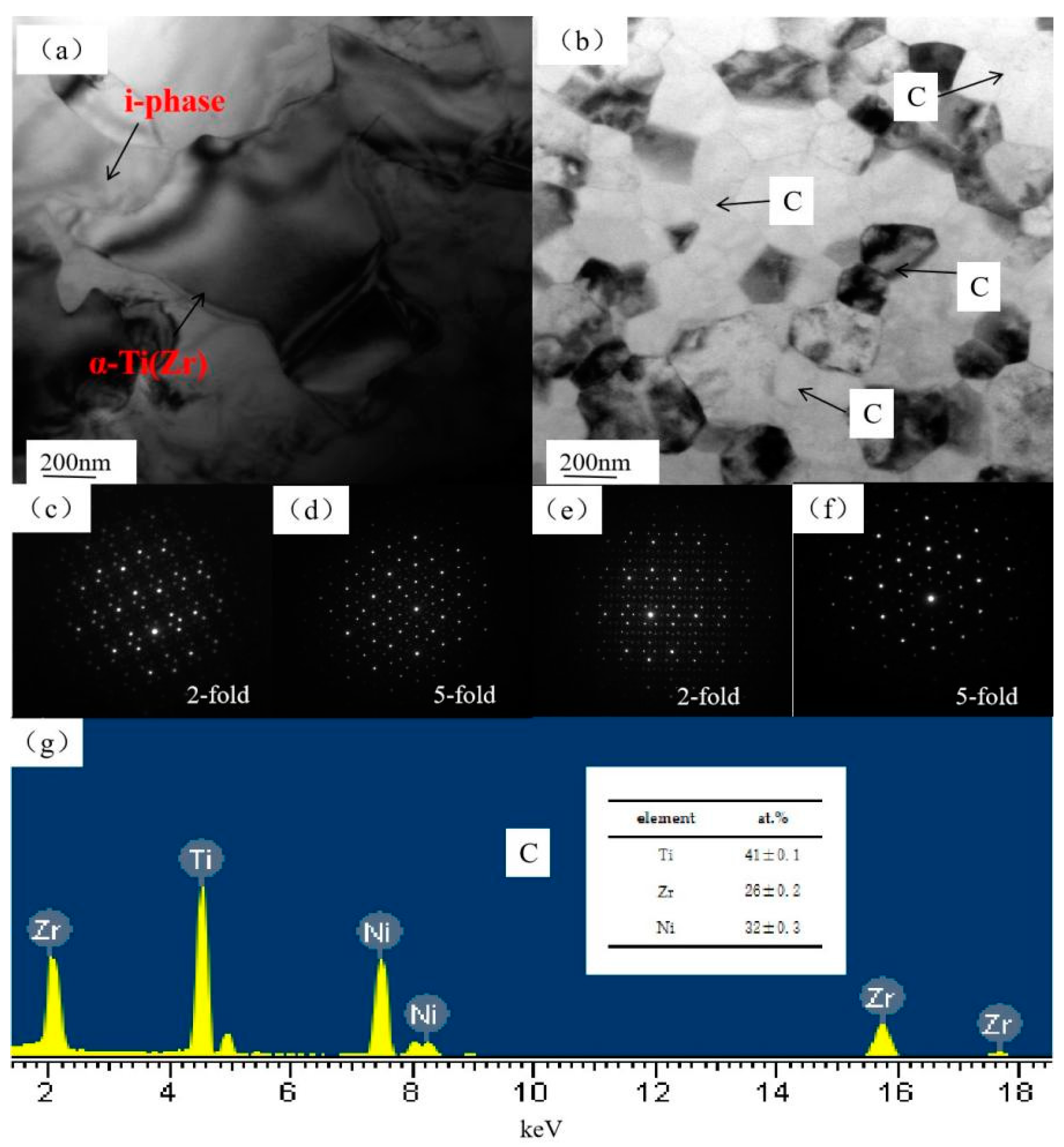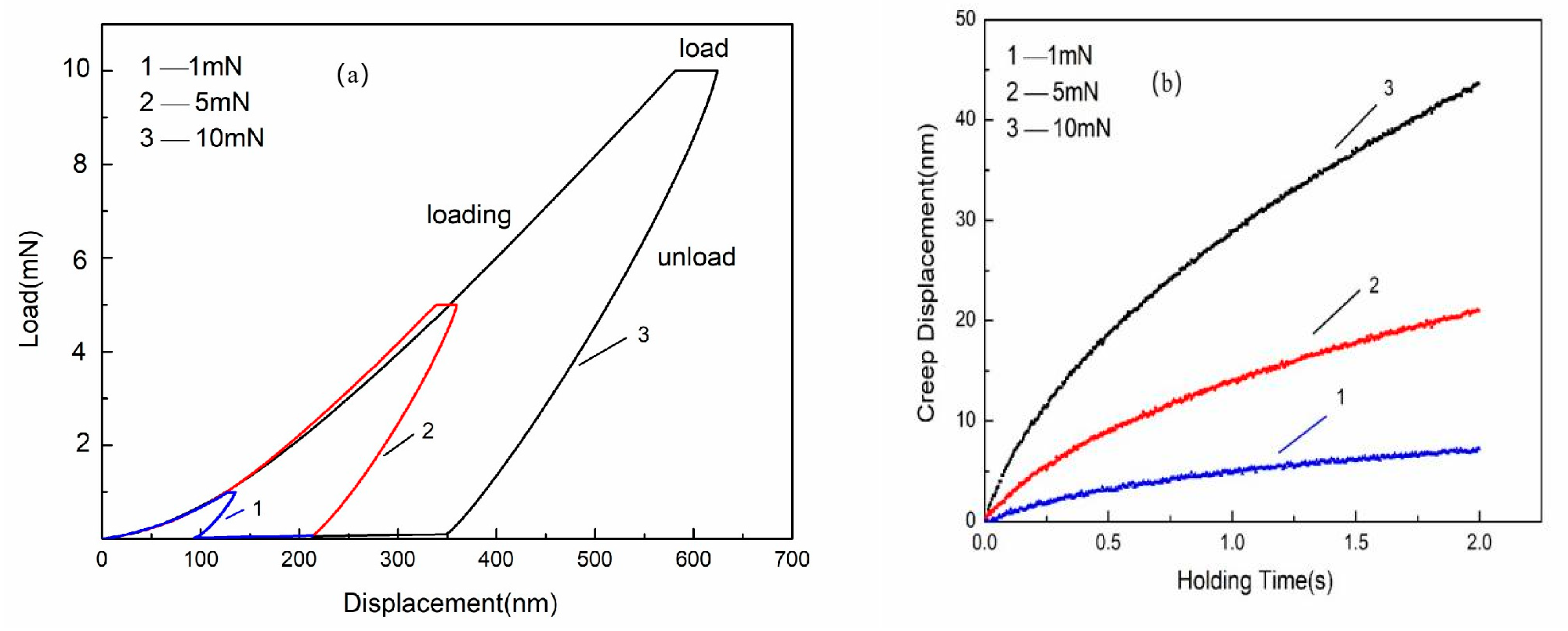Microstructure and Nanoindentation Behavior of Ti40Zr40Ni20 Quasicrystal Alloy by Casting and Rapid Solidification
Abstract
:1. Introduction
2. Experimental Procedure
2.1. Arc Melting
2.2. Copper Blow Casting
2.3. Rapid Quenching
2.4. Analysis and Detection Methods
3. Results and Discussion
3.1. Structure Characterization and Morphology
3.2. DSC Analysis
3.3. Nanoindentation Study
4. Conclusions
Author Contributions
Funding
Institutional Review Board Statement
Informed Consent Statement
Data Availability Statement
Acknowledgments
Conflicts of Interest
References
- Dong, C. The Formation mechanism, Properties and Application potentials of quasicrystalline materials. Chin. J. Mater. Res. 1994, 8, 482–490. [Google Scholar]
- Tsai, A.-P. Discovery of stable icosahedral quasicrystals: Progress in understanding structure and properties. Chem. Soc. Rev. 2013, 42, 5352–5365. [Google Scholar] [CrossRef]
- Dubois, J.-M. Properties- and applications of quasicrystals and complex metallic alloys. Chem. Soc. Rev. 2012, 41, 6760–6777. [Google Scholar] [CrossRef]
- De Boissieu, M. Phonons, phasons and atomic dynamics in quasicrystals. Chem. Soc. Rev. 2012, 41, 6778. [Google Scholar] [CrossRef]
- Song, X.F.; Hao, J.M.; Han, L.M.; Feng, X.M. Research Progress of Quasicrystal Application in catalysis, Reinforced Composites and Hydrogen Storage. Chem. Ind. Prog. 2015, 34, 1037–1042. [Google Scholar]
- Li, X.C.; Deng, H.; Chi, Z.Y.; Wang, P.; Sun, Z.H. Research on Material and Structure Characteristics of Quasi -crystal Material. Equip. Manuf. Technol. 2009, 3, 32–34. [Google Scholar]
- Zhang, Q. Preparation and Properties of the Ti-Based Bulk Quasicrystalline Alloys. Master’s Thesis, Jilin University, Jilin, China, 2015. [Google Scholar]
- Dubois, J.M.; Kang, S.S.; Von Stebut, J. Quasicrystalline low-friction coatings. J. Mater. Sci. Lett. 1991, 10, 537–541. [Google Scholar] [CrossRef]
- Takasaki, A.; Kelton, K. Hydrogen storage in Ti-based quasicrystal powders produced by mechanical alloying. Int. J. Hydrogen Energy 2006, 31, 183–190. [Google Scholar] [CrossRef]
- Ryabtsev, S.I.; Polonskyi, V.A.; Sukhova, O.V. Structure and Corrosion of Quasicrystalline Cast Alloys and Al–Cu–Fe Film Coatings. Mater. Sci. 2020, 56, 263–272. [Google Scholar] [CrossRef]
- Lee, K.; Hsu, J.; Naugle, D.; Liang, H. Multi-phase quasicrystalline alloys for superior wear resistance. Mater. Des. 2016, 108, 440–447. [Google Scholar] [CrossRef]
- Leshchinsky, E.; Sobiesiak, A.; Maev, R. Intermetallic Al-, Fe-, Co- and Ni-Based Thermal Barrier Coatings Prepared by Cold Spray for Applications on Low Heat Rejection Diesel Engines. J. Therm. Spray Technol. 2018, 27, 456–470. [Google Scholar] [CrossRef]
- Wolf, W.; Koga, G.Y.; Schulz, R.; Savoie, S.; Kiminami, C.S.; Bolfarini, C.; Botta, W.J. Wear and Corrosion Performance of Al-Cu-Fe-(Cr) Quasicrystalline Coatings Produced by HVOF. J. Therm. Spray Technol. 2020, 29, 1195–1207. [Google Scholar] [CrossRef]
- Ekimov, E.A.; Ivanov, A.S.; Pal, A.; Petrzhik, M.I.; Ryabinkin, A.N.; Serov, A.O. Structure and properties of the ceramics based on quasicrystal powders processed by plasma coating method. J. Physics: Conf. Ser. 2015, 653, 012128. [Google Scholar] [CrossRef] [Green Version]
- Wolf, W.; Travessa, D.N.; Afonso, C.R.M.; Bolfarini, C.; Botta, W.J.; Aliaga, L.C.R.; Kiminami, C.S. Enhancement of Mechanical Properties of Aluminum and 2124 Aluminum Alloy by the Addition of Quasicrystalline Phases. Mater. Res. 2016, 19, 74–79. [Google Scholar] [CrossRef] [Green Version]
- Stan-Głowińska, K.; Lityńska-Dobrzyńska, L.; Kania, B.; Dutkiewicz, J.; Rogal, Ł.; Skuza, W.; Wojewoda-Budka, J.; Gordillo, M.; Wiezorek, J. Effects of hot-compaction on the structure and properties of Al-Mn-Fe-X alloys strengthened with quasi-crystalline icosahedral phase. Mater. Des. 2017, 126, 162–173. [Google Scholar] [CrossRef]
- Li, F.; Tian, L.; Li, R.; Wang, Y.; Liu, Z. Microstructure and wear resistance properties of Al/Al–Cu–Cr–Fe composites consolidated using spark plasma sintering. Compos. Interfaces 2019, 27, 515–527. [Google Scholar] [CrossRef]
- Oliveira, V.S.; Camboim, M.; de Souza, C.P.; de Lima, B.S.G.; Baiocchi, O.; Kim, H.-S. A Thermoelectric Energy Harvester Based on Microstructured Quasicrystalline Solar Absorber. Micromachines 2021, 12, 393. [Google Scholar] [CrossRef] [PubMed]
- Wang, J.B. Formation and Structural Stability of Icosahedral Quasicrystals in Zr-Ti-Ni System. Master thesis, Dalian University of Technology, Dalian, China, 2014. [Google Scholar]
- Zhang, S.S. Study on the Hydrogen-Storage Electrode of the Ti-Based Quasicrystalline Alloys. Master’s Thesis, Changchun University of Science and Technology, Changchun, China, 2012. [Google Scholar]
- Liu, H.; Zhou, X.; Zhai, X.; Tao, X.; Li, Z.; Wang, Q.; Zhao, J.; Liu, W.; Gao, S.; Jiang, D. Influence of LiH addition on electrochemical hydrogen storage performance of Ti45Zr38Ni17 quasicrystal. Solid State Sci. 2018, 87, 53–57. [Google Scholar] [CrossRef]
- Zhai, X.; Li, Z.; Zhou, X.; Liu, H.; Sun, J.; Su, Z.; Liu, W.; Zhao, J. Improved electrochemical hydrogen storage properties of Ti49Zr26Ni25 quasicrystal alloy by doping with Pd and MWCNTs. Int. J. Hydrogen Energy 2019, 44, 29356–29364. [Google Scholar] [CrossRef]
- Lee, S.-H.; Kim, J. Structure and hydrogen absorption properties of Ti53Zr27Ni20 (Pd,V) quasicrystals. Int. J. Hydrogen Energy 2018, 43, 19130–19140. [Google Scholar] [CrossRef]
- Patrick, D.K.; Takasaki, A.; Klimkowicz, A. High discharge capacities of Ti-based quasicrystal electrodes synthesized by mechanical alloying—Retraction. MRS Adv. 2020, 5, 2003. [Google Scholar] [CrossRef] [Green Version]
- Molokanov, V.; Chebotnikov, V. Quasicrystals and amorphous alloys in Ti-Zr-Ni system: Glassforming ability, Structure and Properties. J. Non-Cryst. Solids 1990, 117–118, 789–792. [Google Scholar] [CrossRef]
- Kim, W.; Gibbons, P.; Kelton, K. A new 1/1 crystal approximant to the stable Ti-Zr-Ni icosahedral quasicrystal. Philos. Mag. Lett. 1997, 76, 199–206. [Google Scholar] [CrossRef]
- Qiang, J.B.; Huang, H.G.; Wang, Y.M.; Jiang, N.; Dong, C. Compositional Characteristic of Ternary Quasicrystals in Ti-Zr-Ni System. Acta Metall. Sin. 2004, 40, 677–682. [Google Scholar]
- Shahi, R.R.; Yadav, T.; Shaz, M.; Srivastava, O. Synthesis characterization and hydrogenation behaviour of as quenched Ti41.5+XZr41.5−XNi17 (x = 0, 3.5, 11.5 and 13.5) nano quasicrystalline ribbons. J. Phys. Conf. Ser. 2017, 809, 12011. [Google Scholar] [CrossRef]
- Cahn, J.W.; Shechtman, D.; Gratias, D. Indexing of icosahedral quasiperiodic crystals. J. Mater. Res. 1986, 1, 13–26. [Google Scholar] [CrossRef] [Green Version]
- Kelton, K.F. Solidification Studies of Nanocrystalline and Quasicrystalline Materials from the Undercooled State. PhD thesis, Washington University, Washington, DC, USA, 2001. [Google Scholar]
- Qiang, J.B.; Wang, Y.M.; Wang, D.H.; Dong, C. On the Phase Transformation of Bulk as-Cast Ti40Zr40Ni20 Quasicrystal. Rare Met. Mater. Eng. 2004, 9, 949–952. [Google Scholar]
- Wang, C.; Wang, Y.; Gao, L.; Li, G.; Xia, Y.; Dong, C. Laser-induced self-propagating high-temperature synthesis of amorphous- and quasicrystal-containing composite materials. J. Non-Cryst. Solids, 2004; 334–335, 51–516. [Google Scholar] [CrossRef]
- Li, C.Y.; Zhu, F.P.; Ding, J.P.; Yin, J.F.; Wang, Z.; Zhao, Y.C.; Kou, S.Z. Investigation on Creep Behavior of Zr-based Bulk Metallic Glass by Nanoindentation. Rare Met. Mater. Eng. 2020, 49, 3353–3360. [Google Scholar]
- Zheng, H.W.; Shu, X.Y.; Li, Y.; Zhao, J.P. Nanoindentation Mechanical Properties of Fe60Cr5Mo2Ni2W2Mn1-C4Si7B17 Amorphous Alloy. Mater. Mech. Eng. 2018, 42, 36–41. [Google Scholar] [CrossRef]
- Amiya, K.; Nishiyama, N.; Inoue, A.; Masumoto, T. Mechanical strength and thermal stability of Ti-based amorphous alloys with large glass-forming ability. Mater. Sci. Eng. A 1994, 179–180, 692–696. [Google Scholar] [CrossRef]
- Shen, X.J. Study on the Structure and Mechanical Properties of Metal Glass Reinforced Ti Alloy Composite by 3D Printing. Master’s Thesis, Huazhong University of Science & Technology, Wuhan, China, 2019. [Google Scholar]
- Yao, X.J.; Wang, K.; Gao, L.; Zhang, X.B.; Liu, C. Microstructure and properties of TC16 titanium alloy cold rolling external thread. Sci. Technol. Innov. 2021, 26, 38–41. [Google Scholar]
- Shaz, M.; Mukhopadhyay, N.; Mandal, R.; Srivastava, O. Synthesis and microhardness measurement of Ti–Zr–Ni nanoquasicrystalline phase. J. Alloys Compd. 2002, 342, 49–52. [Google Scholar] [CrossRef]
- Qiang, J.B.; Yu, Z.W.; Huang, H.G.; Jiang, N.; Dong, C. Mechanical properties of the single-phase Ti-Zr-Ni quasicrystalline alloy at roomtemperature. Acta Phys. Sin. 2005, 54, 1909–1913. [Google Scholar]
- Zhao, L.R. Studies on the Formation and Thermodynamic and Mechanical Properties of Zr-Ti-Ni-Be Quasicrystal. Master’s Thesis, Yanshan University, Qinhuangdao, China, 2015. [Google Scholar]
- Ding, X.R. Study on the Microstructure and Mechanical Properties of Mechanical Alloying and Hot Pressing Sintered Ceramics. Aging Appl. Synth. Mater. 2021, 50, 102–104. [Google Scholar] [CrossRef]
- Huang, J.K.; Liu, Y.L.; Liu, G.Y.; Yang, M.H.; Fan, D. Nanomechanical Analysis of Anisotropy of Single Crystal Copper on Micro-Nano Scale. Mater. Rep. 2021, 24, 1–12. [Google Scholar]
- Yang, C.J.; Zhang, C.T. Experimental Research on Mechanical Properties of Q355 Steel Cooled by Water after Fir. Ind. Constr. 2021, 271, 121605. [Google Scholar]
- Jin, J.; Ji, X.L.; Duan, J.; Liu, Z.H.; Wang, H.; Zhang, Y.T. Effect of Cryogenic-thermal Cycling Treatment on the Tribological Properties of Fe-based Bulk Amorphous Alloy. Tribology 2021, 865, 158993. [Google Scholar]
- Wang, X.; Shao, Y.; Gong, P.; Yao, K. Effect of thermal cycling on the mechanical properties of Zr41Ti14Cu12.5Ni10Be22.5 alloy. Sci. China Ser. G Physics Mech. Astron. 2012, 55, 2357–2361. [Google Scholar] [CrossRef]







| T(K) | Sample | |
|---|---|---|
| Rod | Ribbons | |
| 867 | α→β | - |
| 950 | I→β + C14 phase | - |
| 1109 | β + C14 phase→Liquid | I→Liquid |
Publisher’s Note: MDPI stays neutral with regard to jurisdictional claims in published maps and institutional affiliations. |
© 2021 by the authors. Licensee MDPI, Basel, Switzerland. This article is an open access article distributed under the terms and conditions of the Creative Commons Attribution (CC BY) license (https://creativecommons.org/licenses/by/4.0/).
Share and Cite
Hou, J.; Yang, Z.; Duan, H.; Feng, Y.; Guo, Y.; Li, J. Microstructure and Nanoindentation Behavior of Ti40Zr40Ni20 Quasicrystal Alloy by Casting and Rapid Solidification. Metals 2021, 11, 1563. https://doi.org/10.3390/met11101563
Hou J, Yang Z, Duan H, Feng Y, Guo Y, Li J. Microstructure and Nanoindentation Behavior of Ti40Zr40Ni20 Quasicrystal Alloy by Casting and Rapid Solidification. Metals. 2021; 11(10):1563. https://doi.org/10.3390/met11101563
Chicago/Turabian StyleHou, Junli, Zhong Yang, Hongbo Duan, Yiyi Feng, Yongchun Guo, and Jianping Li. 2021. "Microstructure and Nanoindentation Behavior of Ti40Zr40Ni20 Quasicrystal Alloy by Casting and Rapid Solidification" Metals 11, no. 10: 1563. https://doi.org/10.3390/met11101563
APA StyleHou, J., Yang, Z., Duan, H., Feng, Y., Guo, Y., & Li, J. (2021). Microstructure and Nanoindentation Behavior of Ti40Zr40Ni20 Quasicrystal Alloy by Casting and Rapid Solidification. Metals, 11(10), 1563. https://doi.org/10.3390/met11101563







